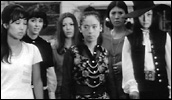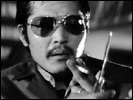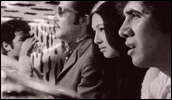Stray Cat Rock: Sex Hunter
- Year
- 1970
- Original title
- Noraneko Rokku Sekkusu Hanta
- Japanese title
- X 野良猫ロック セックス・ハンター
- Alternative title
- Alleycat Rock: Sex Hunter
- Director
- Cast
- Running time
- 85 minutes
- Published
- 4 August 2004



by Tom Mes
Those who like their cinema with a bit of spunk can't go wrong with Japan's exploitation films of the 1970s. Too often overlooked in histories of the country's cinema, the gaudy, sensational, and hugely entertaining films unleashed by the major studios in an attempt to lure an increasingly disinterested audience back into the theaters were a breeding ground for some truly audacious and inventive filmmaking.
Experiencing its heyday roughly between 1971 and 1976, with Nikkatsu's Roman Porno and Toei's Pinky Violence as its two main streams, Japanese exploitation benefited from solid production values and a new wave of talent both in front of and behind the camera. With avid young helmers like Tatsumi Kumashiro, Kinji Fukasaku, and Shunya Ito, and the sultry star power of such actresses as Meiko Kaji, Naomi Tani, and Miki Sugimoto, the 1970s are a treasure trove of pleasure - guilty and otherwise.
Nikkatsu's Stray Cat Rock series of delinquent girl gang films can be considered as one of the forerunners of this phenomenon. Consisting of five episodes made in 1970 and 1971, it is boxed in between the lurid pop art explosions characteristic of much of Nikkatsu's output of the 60s, as exemplified most irreverently by the work of Seijun Suzuki, and the more shameless and graphic exploitation cinema of the 1970s. Closer in spirit to the former in its abundant go-go dancing, musical interludes, and nightclub scenes, Stray Cat Rock at the same time announced what was to come in its approach to violence and sexuality, as well as in its casting choices, with stars Meiko Kaji and Tatsuya Fuji going on to make indelible marks on the decade that followed.
With Home Vision Entertainment's DVD release of the third entry in the series, Sex Hunter, we have the opportunity to gauge Stray Cat Rock's role as a bridge between two distinct periods in Japanese popular cinema. Directed by Yasuharu Hasebe, who was prolific in both eras with such choice works as Black Tight Killers for Nikkatsu in 66 and Sukeban Deka: Dirty Mary for Toei in 74 (plus a good number of the more notorious Roman Porno entries such as Assault! Jack the Ripper / Boko Kirisaki Jakku and Rape! / Okasu!), Sex Hunter evolves from the studio's tradition of mukokuseki (borderless) action: the use of foreign genre templates rather than homegrown stalwarts like the jidai-geki or ninkyo yakuza films. In this case, the template is the western, with the plot seeing the arrival of a stranger in a town ruled by a vicious band of thugs, building up to a duel between the stranger and the gang leader at high noon. At the same time, the film's female protagonists announce the copious number of powerful and vengeful females that would populate the exploitation films of the 70s, Meiko Kaji's own turns as Female Convict Scorpion and Lady Snowblood foremost among them.
Stray Cat Rock: Sex Hunter's storyline concerns the rivalry between the all-female gang the Alleycats, led by the sultry Mako (Kaji), and the brazen young men who form the Eagles, headed by the ultra-cool Baron (Fuji). When Alleycat Mari turns down the advances of Eagle Susumu in favour of her half-black boyfriend Ichiro, Baron's memories of his sister's rape by a group of halfbreeds spurs on the Eagles to rid the town of its mixed-race population. When a young stranger named Kazuma (Yasuoka) wanders by in search of his estranged sister, Mako takes a fancy to him, none to the liking of Baron, who goes in hot pursuit as soon as he realises that the stranger is also a halfbreed.
Sex Hunter makes a particular point of race relations and questions of nationality, refusing to draw a clear line to indicate which ethnicity is 'good' and which is 'bad'. The film suggests that mixing the colours might well be a way to building a slightly better world, condemning the domination of one group over another (and by extension of one culture over another, as the pernicious presence of American cultural ephemera throughout the film attests - it was shot near the U.S. naval base in Yokosuka). Pivotal in this regard are the frequent appearances of the all-girl pop group Golden Half, who during seventies scored hit after hit and whose five members were all offspring of Japanese mothers and foreign fathers, the exotic looks that resulted from their mixed heritage being their main sales point.
As relatively mono-ethnic as Japan for a long time may have been, the country and its culture have long had a fascination for the foreign, from the moga ('modern girl') of the Taisho era, who deliberately swapped their kimonos for flapper dresses, to the current fad for Korean Kool. However, at the time of Stray Cat Rock's production, ethnic minorities as a prominent and positive presence in mainstream cinema had yet to arrive, Bruce Lee and blaxploitation not making their mark internationally for another few years.
In Japan, it had mostly been the independent filmmakers of the New Wave that had touched on the subject of ethnic minorities, which makes the studio production Sex Hunter quite a daring statement for its time (although precedent exists in form of Tai Kato's Toei-produced gang film By a Man's Face Shall You Know Him from 1966). Granted, it might not have existed in this form without the popularity of Golden Half, and the Italian roots of Rikiya Yasuoka hadn't been a hindrance to his career up to that point, but the value of the film's treatment of this subject lies in how it treats it, not that it treats it.
Impeccably stylised and undeniably cool - room temperature drops during Tatsuya Fuji's superb close-ups - and with an intriguingly ambivalent approach to its characters (and look quick for a bit part by Tomio Aoki as a bartender), the unearthing of Stray Cat Rock: Sex Hunter has been a worthy effort indeed.